Why you should remove your burning bush - and what to plant instead
Burning bush (Euonymus alatus) is a popular landscaping plant known for its fiery fall colour—but it’s also an aggressive invasive species that threatens our native ecosystems.

Hi readers! Today we’re looking at an invasive shrub that, despite its popularity in landscaping, is causing negative impacts on biodiversity in our forests. Stay tuned for an upcoming video where yours truly is caught in action removing a backyard population of these spreading beasts!
Burning bush (aka winged euonymus), Euonymus alatus, is one of the most popular landscaping plants in eastern North America. The name says it all - in the fall, the leaves turn a fiery red colour that mimic the natural beauty of the changing forest. If you’re not familiar with this plant, go for a walk in any neighbourhood in late September or October and it will certainly catch your eye on every block. Most landscaping companies will add at least one of these plants to residential designs, and multiples to commercial designs. They are easy plants to care for, growing rapidly and providing a stunning element to the garden in the fall months.
However, most people don’t realize that this plant spreads to natural areas with the help of birds, who are attracted to its bright red berries. They’ll fly into a bush, devour the berries, and deposit them en route to their next destination. This becomes a problem when the digested seeds land in forests and other natural areas. With a high germination rate, these seeds can start growing in a variety of habitats, producing thickets and crowding out native plants. They grow rapidly and shade the soil, preventing other plants, including trees, from germinating. This makes it difficult for forests to regenerate.
*Learn more about the problems caused by invasive plants here.
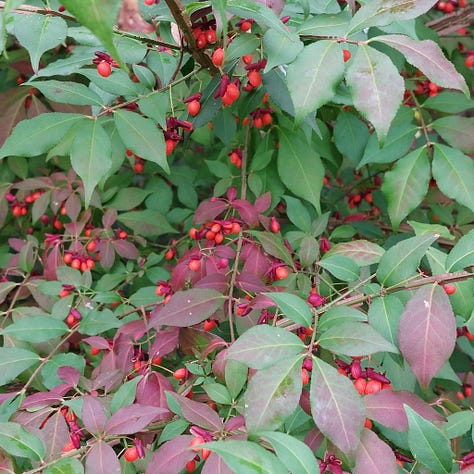
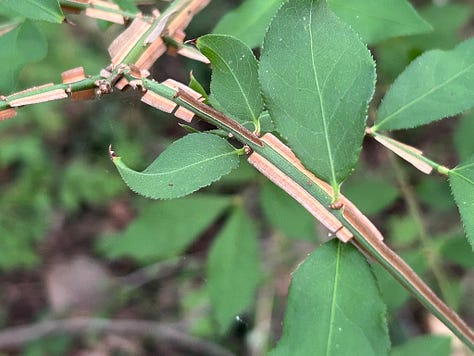
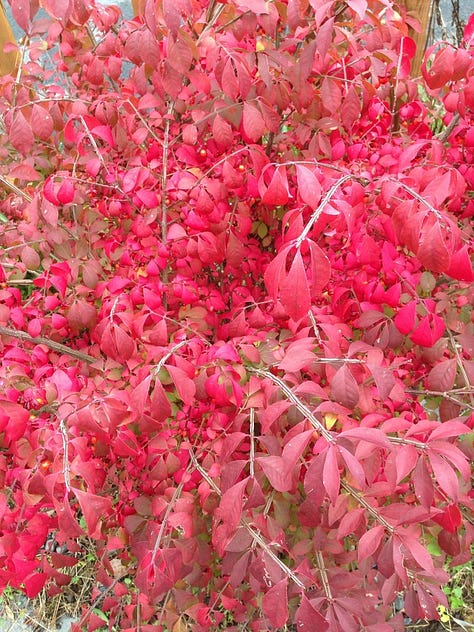
But my plant isn’t spreading - it’s the only one in my yard!
This is a common reaction when learning that your property hosts a problematic plant that spreads by seeds - you often don’t see the repercussions, but ecologists and conservationists will tell you otherwise. They’ve been hard at work finding solutions to the problems caused by invasive plants that have travelled from gardens to natural spaces. They would have less of these problems to deal with if there were adequate regulations in the horticulture industry, but I digress…
Here are a couple of examples of how these prized plants take over forest ecosystems. Imagine what areas like this will look like in 50 or 100 years without intervention. They will become unrecognizable ecosystems, supporting a minimal amount of diversity. They’ll look pretty for a few weeks in the fall and that will be it. Is it really worth it to allow these plants in our landscapes?
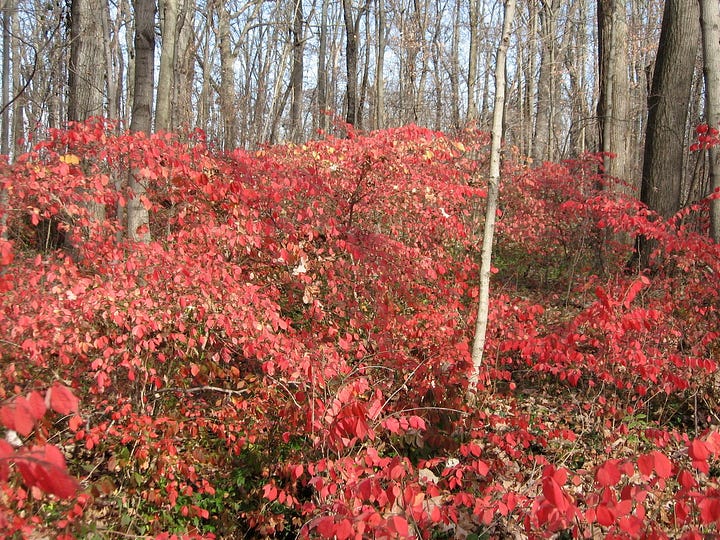
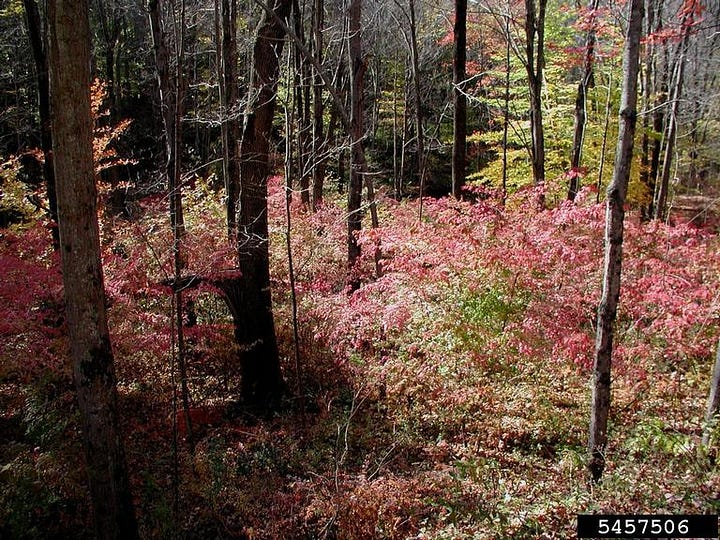
So you’ve decided that you’re going to remove your beautiful burning bush. To give up its one nice quality in order to help preserve the biodiversity of our surrounding forests. Great decision! But now what? How do you remove it and what do you do with the remaining debris? What should you plant instead?
How to properly remove and dispose of burning bush
Dig it up! Luckily, burning bush roots are fairly shallow, so digging them up and removing the roots isn’t too difficult.
I usually cut the branches down first - it makes digging a lot easier if they’re not in the way. However, if the plant has started to produce seeds, you’ll need to put these branches into black plastic garbage bags to solarize and destroy the seeds, and ensure that they don’t germinate elsewhere. To avoid this step, dig your burning bush up in the spring or early summer, before the seeds start to form.
If it is in a single-stemmed form, you can use a weed wrench (like the Canadian made Pullerbear) to pull it up and out by the roots.
If it’s multi-stemmed, you’ll need to use shovels and/or mattocks to dig around the root ball until it is loosened and you can pull the plant over.
Once your plant is out of the ground, use a garden fork to sift through the soil and remove any remaining roots that have the potential to resprout.
Disposal: Viable parts need to be destroyed (seeds and roots) in order to prevent further spread. Roots can be left in the sun to dry out, while seeds should be put in garbage bags and placed in the sun for 2-3 weeks before disposal. Branches can be piled up and used as refuge for wildlife, they can be chipped and used as mulch or they can be picked up by your municipal yard waste program.
The Ontario Invasive Plant Council publishes and updates Best Management Practices documents for a variety of invasive plant species that are commonly found in residential gardens. These documents provide all the information you need to know about the history of the plant, its defining characteristics and how best to manage it, based on years of scientific research.
Congratulations, your burning bush is gone and you’ve disposed of it responsibly! Now what? You have an area (or areas) of your landscaping that need to be filled in. There are many different native plants that fill these niches nicely!
Native plant alternatives for burning bush
Burning bushes come in different forms, from multi-stemmed shrubs (small and large) to single-stemmed small trees. They are happy to grow in shade, part shade and full sun and tolerate medium-wet, medium and dry soils - so it’s not too hard to find a native plant that will be able to take over your particular landscape conditions. Let’s look at a few, based on form;
Small trees
Pagoda dogwood (Cornus alternifolia): If you’re looking for a graceful tree with beautiful fall foliage, this one is for you! It is an understory or forest edge tree, so does well in part shade conditions. The horizontal branches produce clusters of white flowers in the spring, which help support many different species of insects. These flowers turn into reddish-purple berries which are devoured quickly by hungry birds.
Serviceberry (Amelanchier spp.): There are a few different species of Amelanchiers, some of which grow in single-stem, understory tree form. All have lovely white flowers in the earliest days of spring. These flowers are important food sources for early season insects, like overwintering queen bumblebees and eastern comma butterflies. The red berries (edible for humans!) get quickly snatched up by birds. Amelanchier leaves turn into incredible orange and red colours in the fall.
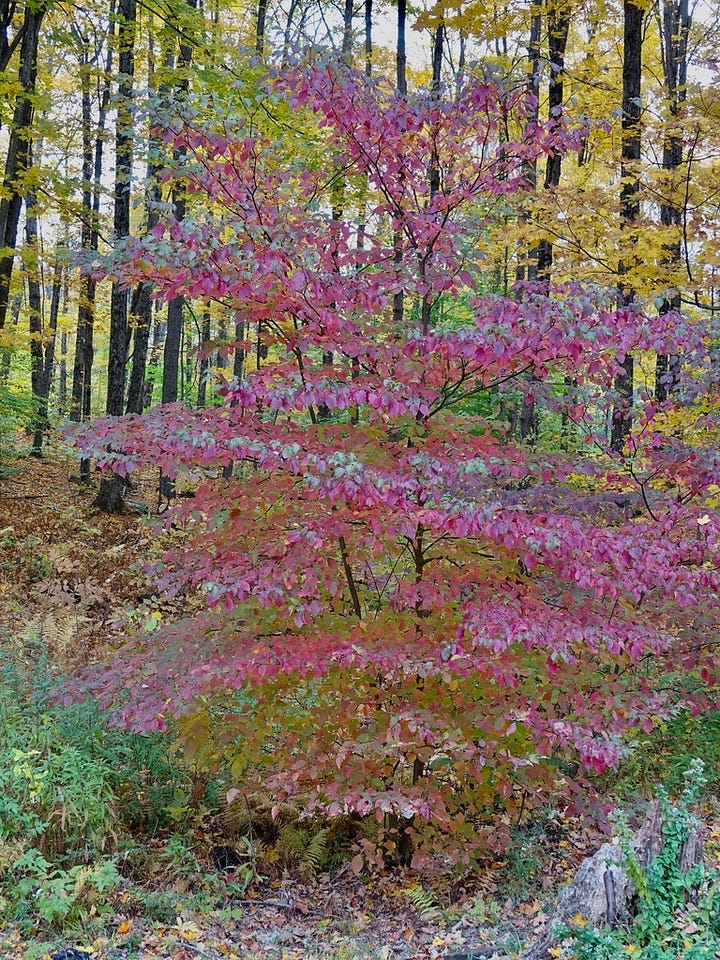
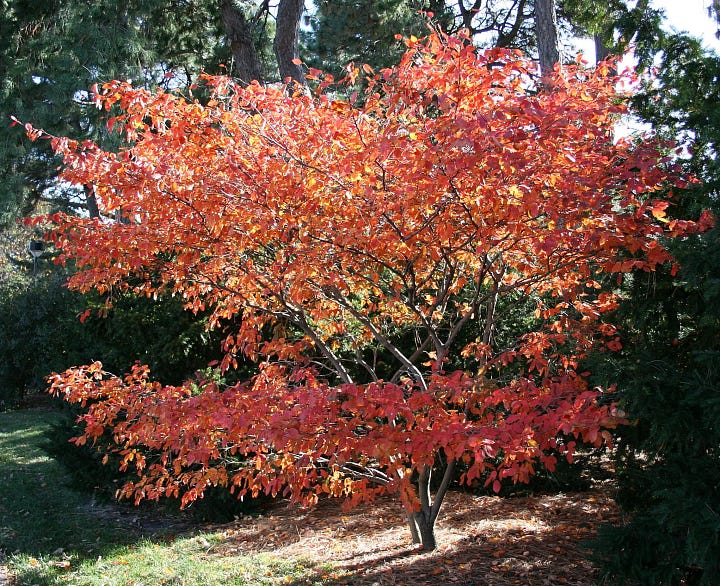
Shrubs
Serviceberry (Amelanchier spp.): See above! There are also many amelanchier species that grow in a multi-stemmed, tall shrub form.
Fragrant sumac (Rhus aromatica): Stunning fall colours? You’ve got it with this one! And its flowers support numerous butterflies, it provides habitat for bees, and its berries support birds in the winter months. Fragrant sumac can grow between 3 and 6 ft (1-2 m) high, and spreads by suckers, making it a good alternative to burning bush hedges.
Black chokeberry (Aronia melanocarpa): This glossy leaved shrub produces white flowers and dark purple-black berries, and turns a brilliant red colour in the fall. It’s happiest in part-shade and medium-wet soil. It grows between 3 and 6 ft (1-2 m) tall, so it’s a good replacement for the smaller burning bushes.
Northern bush honeysuckle (Diervilla lonicera): A great plant for part-shade to shady conditions and dry soil. Growing up to about 3 ft (1 m) high, its leaves turn from green to yellow and then to red in the fall. The yellow flowers are an important food source for many native bees.
Blueberry (Vaccinium spp.): Why not grow your own blueberries in your yard, support bees and birds and enjoy some brilliant fall colours at the same time? Most blueberry species require a fair amount of sun to produce berries.
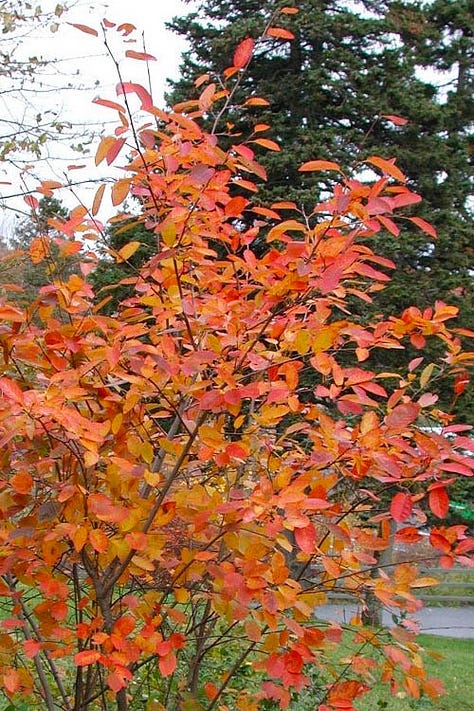
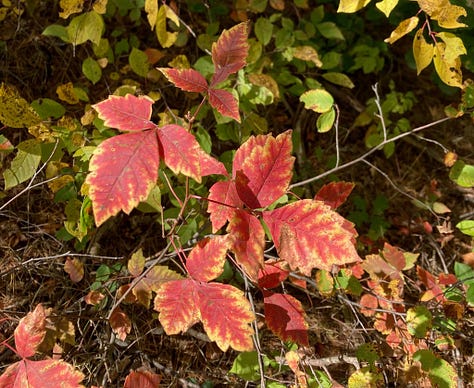
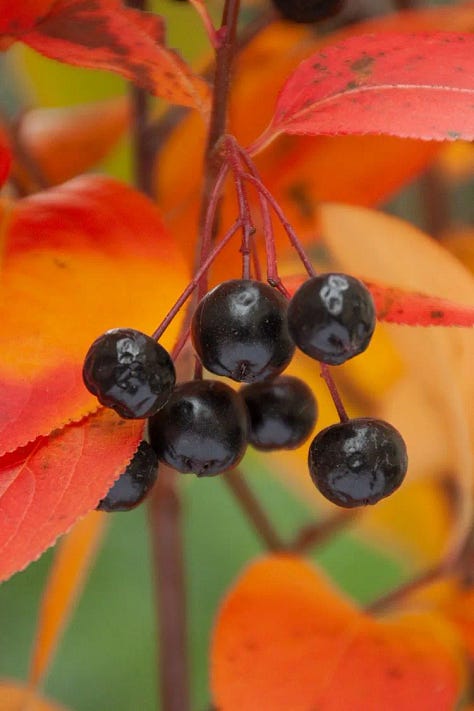
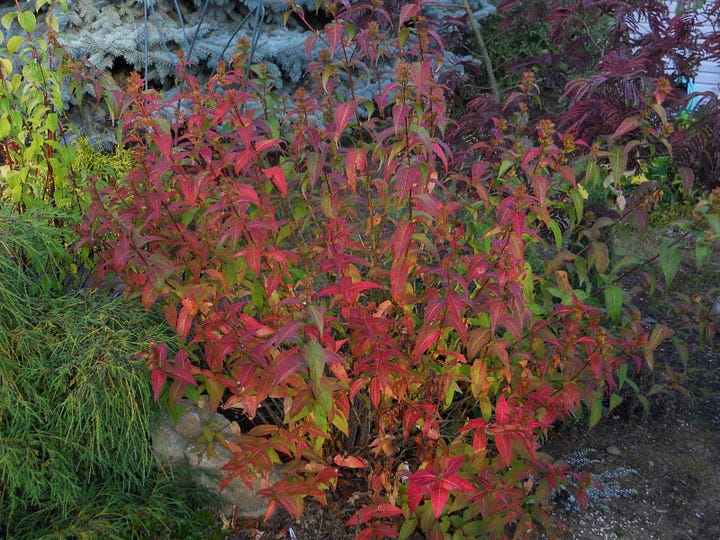
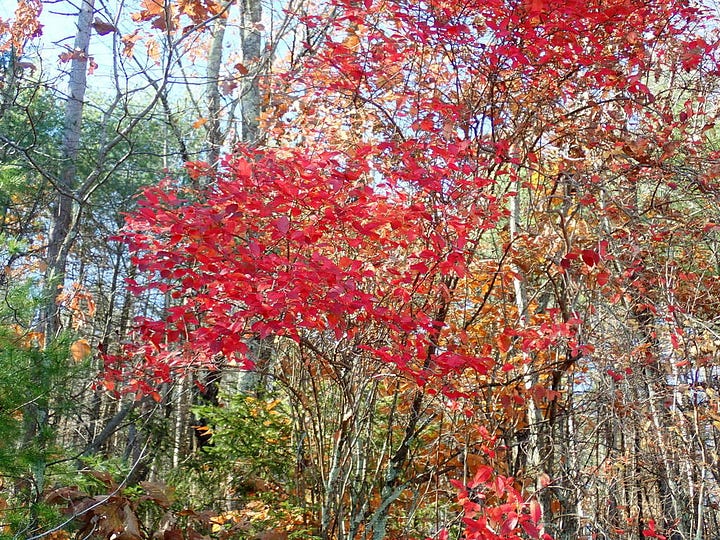
These are all great native plants to replace your burning bush with, and support your local ecosystem in the process, but you can also consider adding some native perennials and ground covers along with the trees or shrubs in order to increase the amount of biodiversity in your landscape. Your local butterfly, bee and bird populations will appreciate the support! Check out some of the resources below to find plants suitable for your site.
Removing invasive plants like burning bush might feel like a small act, but it’s part of a much bigger effort to protect biodiversity and restore balance in our ecosystems. If you’ve made this choice - great work! Share your success, inspire your neighbours, and keep learning about native alternatives. Our individual actions contribute to greater changes!
Follow our social media pages for more pics and tidbits
Resources:
Canadensys - Database of Vascular Plants of Canada (VASCAN)
CCIPR: Canadian Coalition for Invasive Species Regulation
Credit Valley Conservation Authority - Priority Invasive Plants
National Wildlife Federation - Nonnative plants: Ecological Traps?
Native Plant Connection - Native Plant Nurseries in Ontario
Ontario Invasive Plant Council - Winged Euonymus Best Management Practices
Pollinator Partnership Canada - Ecoregional planting guides
Pullerbear - Weed wrench
Reconnect - Native Plant Nursery
USDA - Plants Database




